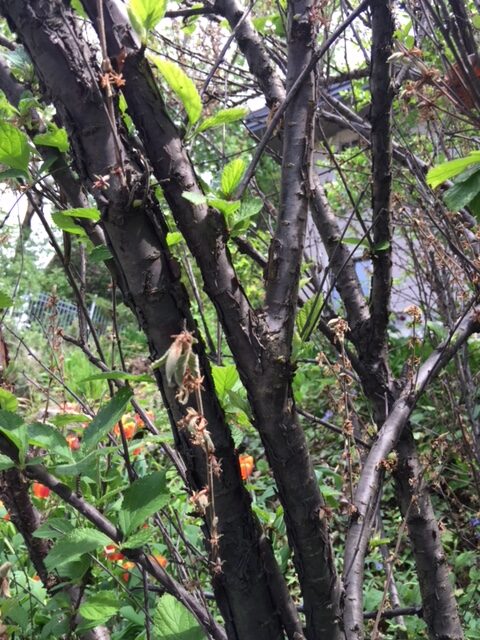
I am asking about disease in an old shrub 8 ft tall, identified on Picture This and on I Naturalist as Prunus, or Plum Cherry. It had prolific white blooms on either side of and close to the stems this spring and now has almost no leaves with some dead ones that seem to be left from last year. It was not healthy last year and had fewer flowers and a few more leaves. I sprayed with a fungicide which may have helped a bit. One of the roses about 15 ft away has a similar problem this year. Do I spray this repeatedly this year and hope or is it probably a lost cause.
Thank you for contacting Toronto Master Gardeners about the leaf and flower loss on your prunus shrub. A variety of bacterial and fungal diseases affect Prunus species. Your image shows several small branched with brown and wilted leaves while other branches appear to have normal looking leaves. It is difficult to see the condition of the bark. That you have sprayed with a fungicide with minimal affect would suggest that further spraying will not be effective. A consultation with an arborist would give you more specific information on the condition of the bush. You can find a certified arborist at https://landscapeontario.com/
Verticillium wilt, caused by Verticillium albo-artrum or Verticillium dalhiae fungus, is a common characteristic of this type of gradual die back in over 300 plant species. The actual organism can only be verified through testing. You could look at a cross section of a live branch to see if the water carrying channels (sapwood) show the characteristic signs of a fungal infection. You might also look at the bark at the base of the bush for signs of disease; if present, will indicate the extent of the disease. When pruning any plant, disinfecting tools between each cut is very important to prevent the spread of plant diseases. There is no known cure for this soil born fungus. The life of your shrub might be extended by reducing environmental stress, e.g. ensuring that it is well watered, mulched, etc. Remove the affected branches discarding these in the garbage. Verticillium fungus can persist in the soil for many years. Choose verticillium resistant plants if you choose to replant the area. Providing for the growing requirements for all plants, particularly during periods of environmental stress, helps maintain their resistance to verticillium wilt and other plant diseases and pests.
For more information:
https://www.torontomastergardeners.ca/askagardener/verticillium-wilt-dispose-of-fall-leaves/

